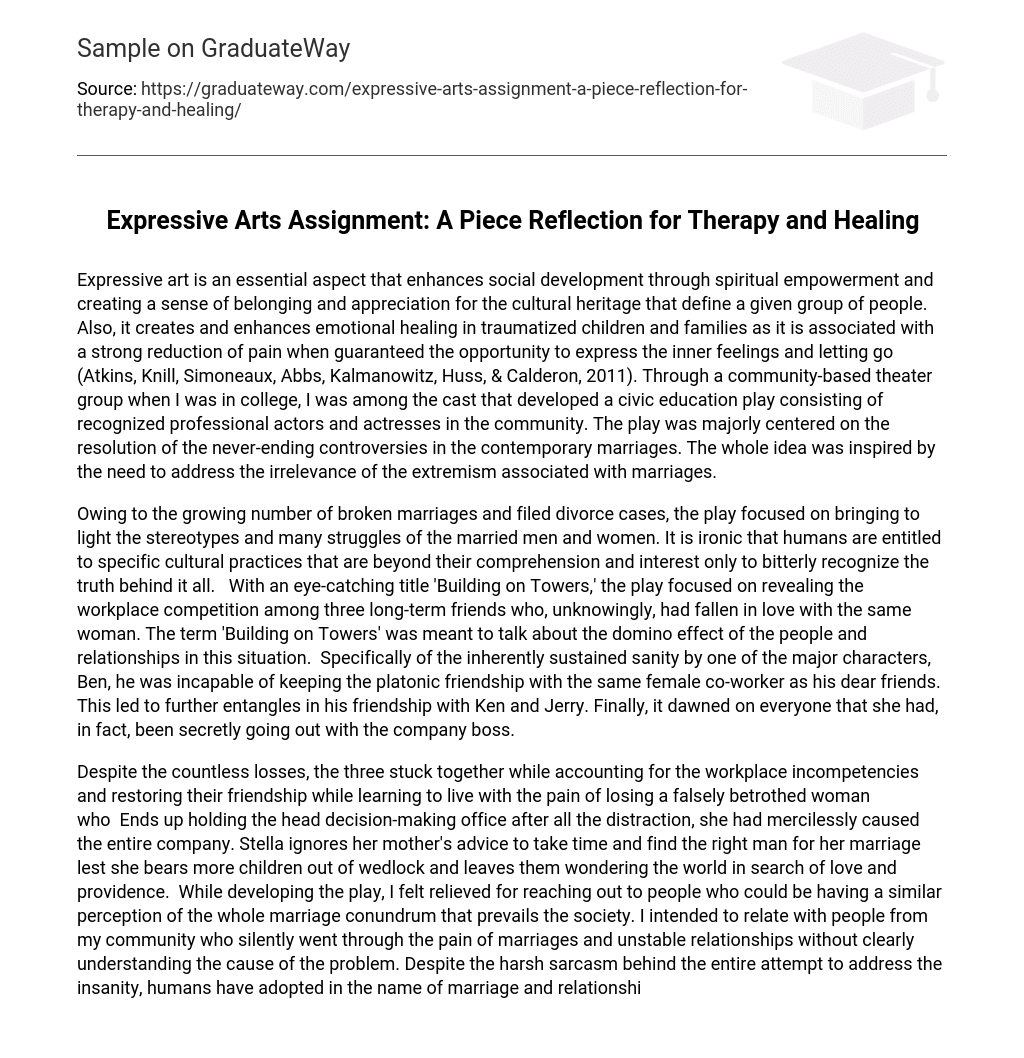Expressive art is an essential aspect that enhances social development through spiritual empowerment and creating a sense of belonging and appreciation for the cultural heritage that define a given group of people. Also, it creates and enhances emotional healing in traumatized children and families as it is associated with a strong reduction of pain when guaranteed the opportunity to express the inner feelings and letting go (Atkins, Knill, Simoneaux, Abbs, Kalmanowitz, Huss, & Calderon, 2011). Through a community-based theater group when I was in college, I was among the cast that developed a civic education play consisting of recognized professional actors and actresses in the community. The play was majorly centered on the resolution of the never-ending controversies in the contemporary marriages. The whole idea was inspired by the need to address the irrelevance of the extremism associated with marriages.
Owing to the growing number of broken marriages and filed divorce cases, the play focused on bringing to light the stereotypes and many struggles of the married men and women. It is ironic that humans are entitled to specific cultural practices that are beyond their comprehension and interest only to bitterly recognize the truth behind it all. With an eye-catching title ‘Building on Towers,’ the play focused on revealing the workplace competition among three long-term friends who, unknowingly, had fallen in love with the same woman. The term ‘Building on Towers’ was meant to talk about the domino effect of the people and relationships in this situation. Specifically of the inherently sustained sanity by one of the major characters, Ben, he was incapable of keeping the platonic friendship with the same female co-worker as his dear friends. This led to further entangles in his friendship with Ken and Jerry. Finally, it dawned on everyone that she had, in fact, been secretly going out with the company boss.
Despite the countless losses, the three stuck together while accounting for the workplace incompetencies and restoring their friendship while learning to live with the pain of losing a falsely betrothed woman who Ends up holding the head decision-making office after all the distraction, she had mercilessly caused the entire company. Stella ignores her mother’s advice to take time and find the right man for her marriage lest she bears more children out of wedlock and leaves them wondering the world in search of love and providence. While developing the play, I felt relieved for reaching out to people who could be having a similar perception of the whole marriage conundrum that prevails the society. I intended to relate with people from my community who silently went through the pain of marriages and unstable relationships without clearly understanding the cause of the problem. Despite the harsh sarcasm behind the entire attempt to address the insanity, humans have adopted in the name of marriage and relationship terms, scripting, rehearsing, acting, and stage-showing the play gave me a sense of emotional satisfaction and relation with the people who appreciated the creativity and relevance of the message conveyed by the play. Also, being in a position to reach out to a large number of the community people, the play successfully portrayed the precautions and civilization required in the approach towards marriage and home establishment.
By emphasizing on uncertainty as a critical social vice in a social relationship, the play aimed at creating an in-depth understanding among the people of the relevant factors to consider for a sustainable marriage in the contemporary society to ensure families and children are established on stable agreements and grounds of social-economic evaluation to retain the supply of the essential resources that potentially sustain families. As one of the youths, I appreciate the fact that there is a need for proper parenting and sustainable family development to ensure accessibility of the children to quality education and healthcare. This is important for future planning for economic success and personal growth to pave the way for better development and innovations that guarantee social and economic development. Expressive Arts can provide a therapeutic healing for my future clients in the Child Youth & Family track because entitled to better planning and understanding of better ways to deal with the ridiculous attitudes. These can create different assumptions that are emphasized in the cultural marriages to ensure their capacity to choose wisely and make adequate personality and capacity assessment through courtship to select the appropriate partner for marriage with a low possibility of breaking up or divorcing to leave the children devastated. It also hints at the critical role played by friendship in listening and understanding our side of the story for emotional support and resilience after traumatizing family-based break-ups.
With the growing trends in chauvinism behaviors, such as wife battering, unquestionable promiscuity, polygamy materialism, and gender dominance, it is necessary for the future marriage partners to be critical in selecting their soul mates to avoid family break-ups and psychological trauma that hinders self-sustainability and socio-economic development. Therefore, this is evidence of the critical role played by the expressive arts in the inclusion and the emancipation of the masses towards sharing and experience to recognize belonging of the people and empower each other for better decisions in the future. It also gives room for sharing the pain and reaching out to a group of people with a similar opinion or experience to seek a long-term resolution for the future (Kossak, 2009). Decision-making is one of the key human responsibilities that should be driven by evidence and data revealing the possibility of a success.
References
- Atkins, S., Knill, P. J., Simoneaux, G., Abbs, K., Kalmanowitz, D. L., Huss, E., … & Calderon, J.M. (2011).
- Art in action: Expressive arts therapy and social change. Jessica Kingsley Publishers. Kossak, M. S. (2009). Therapeutic attunement: A transpersonal view of expressive arts therapy. The arts in psychotherapy, 36(1), 13-18.





